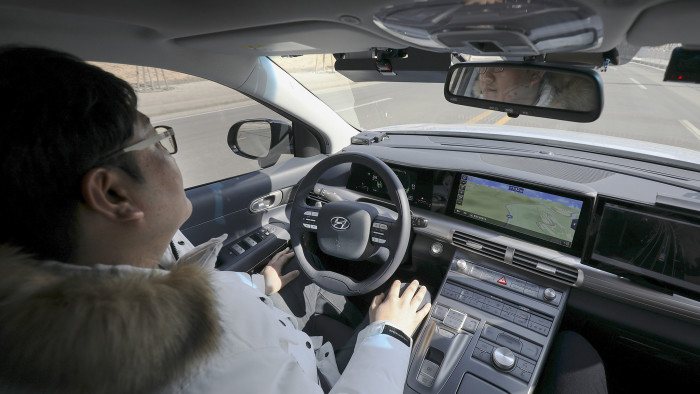Hackers have self-driving cars in their headlights

Simply sign up to the Cyber Security myFT Digest -- delivered directly to your inbox.
With a crunch, the Jeep Cherokee rolled out of the car park and into the grassy ditch. But the terrified person in the driver’s seat, a journalist from Wired, was not controlling the wheel or the pedals.
The car was being controlled by hackers Charlie Miller and Chris Valasek, as part of an experiment-cum-stunt to prove that cars can be accessed, and even driven, remotely.
The incident, which led to a recall of more than 1m Fiat Chrysler vehicles in 2015, was a wake-up call — flagging to the world the dangers hackers pose to the auto industry.
Carmakers are developing self-driving technology to reduce road accidents and facilitate ride-booking services in inner cities. General Motors says it will have driverless cars operating in 2019, while Ford is aiming for 2021 and Renault 2022.
Alphabet’s Waymo unit, regarded as the furthest ahead, has promised a self-driving service without safety drivers in the coming months.
Now a new consideration is racing down the road. As carmakers seek to develop self-driving systems, they have to find ways to prevent those vehicles from being remotely accessed by hackers. This is potentially more difficult as those cars will have far higher levels of connectivity, the most common way in for a hacker, than vehicles currently on the road.
“What is the biggest risk of hacking?” asks David Barzilai, co-founder of Karamba Security, an automotive cyber security company. “In a data centre it is loss of data. With the car it is loss of life. The stakes are so much higher.”
In its most basic form, car hackers find ways into vehicles through connections to the outside world.
The number of connections will rise exponentially once cars are self-driving because of their need to communicate with each other and the network of connected objects, from traffic lights to junctions, around them.
“Human-driven cars have been hacked since they existed,” says Damien Scott, chief commercial officer at Renovo, an autonomous car start-up. Hacking regular cars is costly and often requires physical access as well as specialist equipment.
The addition of cellular connectivity, he says, changes that completely.
“It is the combination of persistent connectivity and self-driving capabilities which presents the nightmare scenario: a scalable exploit that allows a malicious remote attacker, who can conceal their identity and location, to gain direct control over a compromised vehicle’s throttle, brake and steering,” says Mr Scott. “Self-driving cars can and must be designed and operated to make this all-but impossible,” he adds.
Karamba Security has installed verification software within the car’s source code, allowing it to recognise whether commands issued to the vehicle are genuine. Called “intrusion prevention”, it is the car’s equivalent of a burglar alarm.
Craig Smith, research director at cyber analytics group Rapid7 and author of The Car Hacker’s Handbook, believes that fully self-driving cars will be much harder to access than is commonly portrayed.
Cars on the road today that rely on one sensor to detect a vehicle in front can be fooled by hacking into that sensor and tricking it into seeing a person in the road, he argues. But fully autonomous vehicles have layers of sensors that will all communicate thereby making it harder for a hacker to get into.
For carmakers, used to engineering problems as they are discovered, factoring in the potential for cyber attacks at the earliest stages of the design process presents a culture shift.
“Google has been a target of cyber attacks for years, whereas the auto industry hasn’t,” says Mr Smith. “So they have some catching up to do.”
Denis Cosgrove, head of commercial transportation at consultancy Booz Allen Hamilton, adds: “In safety, you can engineer problems away, but in cyber security you have a different mindset . . . You have adversaries who want to break into the system.”
In the UK, the Law Commission is setting up a study to look into criminalising hacking attacks on driverless cars. Their aim is to make sure that humans can still be liable for road accidents.
Ultimately, says Mr Smith, the safety of autonomous cars, which are designed to eliminate most of the million global road deaths a year, will far outweigh the dangers attached to human driving.
Fears about hackers hijacking cars and crashing them are overblown, he says.
“If we’re having a discussion about what’s safe, it’s more likely that you’ll get into a car accident today than someone will hack into your car tomorrow.”
Comments